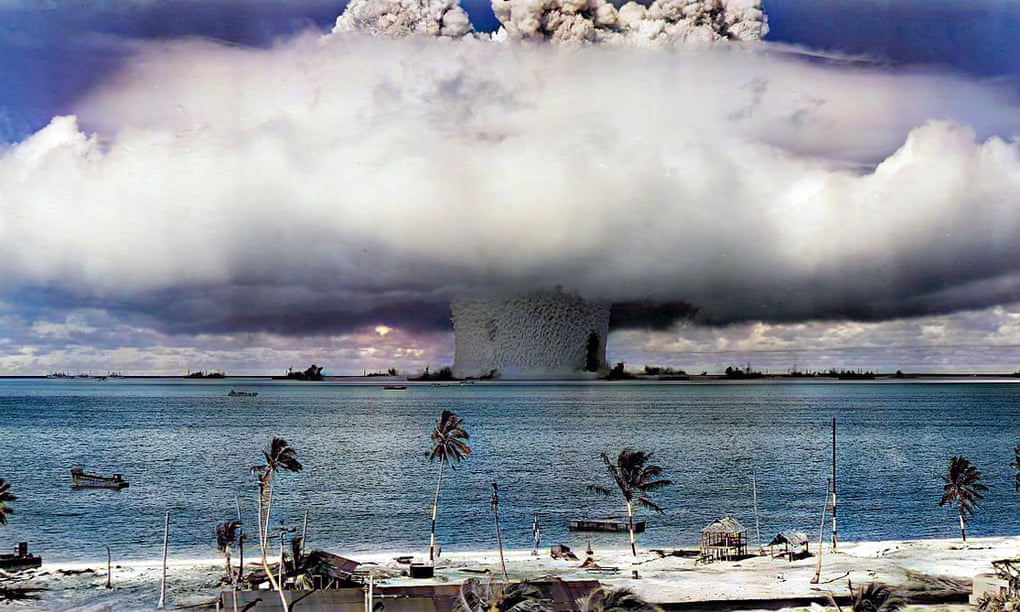
Quand Poutine t'offre du thé...
#meme #numour #putin #putin-khuylo #poutine #putler #plutonium #thé #tea #russie #russia #Ukraine #standwithukraine
6 Likes
3 Comments

#meme #numour #putin #putin-khuylo #poutine #putler #plutonium #thé #tea #russie #russia #Ukraine #standwithukraine
Almost 60 years after British #nuclear tests ended, #radioactive particles containing plutonium and uranium still contaminate the landscape around #Maralinga in #outback South Australia.
#military #waste #Britain #uk #environment contamination #problem #fail #history
Source: https://www.theguardian.com/business/2023/dec/04/sellafield-nuclear-site-hacked-groups-russia-china
https://yt.artemislena.eu/watch?v=nmRYMux0AVk
Des bombes H tombées du ciel en #Espagne en #Andalousie sous Franco et moi qui tombe des nues !
C'est pas croyable ! Impossible de leur faire confiance !
Et toujours pas de trace de la 4eme #bombe au #plutonium, tombée en mer !!!!

This is stated in the message of the National Nuclear Security Administration.
"80 #plutonium cores will be produced annually. Work is also planned to extend the service life of the B61-12 nuclear bombs deployed in #Europe and to modernize the #warheads of the #Trident II intercontinental #ballistic #missiles deployed on submarines."
#US #NuclearWeapons #Militarism #Idiocracy
https://www.energy.gov/sites/default/files/2023-04/FY23%20SSMP_FINAL.pdf
Orwellian naming, the organization in charge of maintaining the nuclear bombs that can (are) killing the planet is named as if it were in charge of safely de-commissioning the bombs and their industry: "National Nuclear Safety Administration". It would be great if there was an organization in charge of getting rid of nuclear bombs and that it wasn't wasteful, abusive, and mismanaged....
NNSA is a semiautonomous branch of the Department of Energy tasked with maintaining the potency of the U.S. nuclear deterrent. NNSA is also described by the GAO as an agency “at high risk of fraud, financial waste, abuse, and mismanagement”.
Lost in all the nuclear equations, appropriations and performance scandals is the consideration that the U.S. is treaty bound by the Nuclear Non-Proliferation Treaty, 1968, to reduce and eventually eliminate its nuclear arsenal, as are the other nuclear armed signatories of the NPT.
Should President Biden and the 118th Congress decide to adhere to its nuclear treaty obligation to reduce nuclear weapons, save hundreds of billions of dollars and avoid the renewal of a nuclear arms race it has embarked upon, then defunding the NNSA’s plutonium pit bomb projects at #LosAlamos and #SavannahRiverSite is the perfect first step.
Plutonium Pit Bomb Plans Excoriated by General Accounting Office by Mark Muhich
#MarkMuhich #Plutonium #CounterPunchMagazine #NPT #NonProliferationTreaty #NoNukes #NNSA #NationalNuclearSafetyAdministration
Radioactive isotopes have shockingly long half-lives – the amount of time it takes them to decay. As a result, radioactive accidents or emergencies potentially leave lifetimes of #toxicity behind in their wake. If you’re a world traveler, it’s worth knowing about some of the most radioactive places on the planet so you can steer clear and prevent exposing yourself to unnecessary doses of direct radiation.
Take Care When Traveling to 5 of the Most Radioactive Places on Earth
Remember learning about half-lives of isotopes in earth science and chemistry? If not, we’ll refresh your memory with this list of commonly-used radioactive isotopes and their half-lives:
#Uranium: 4.5 billion years
#Plutonium 239: 24,300 years
#Plutonium 238: 87.7 years
#Cesium 137: 30.2 years
#Strontium-90: 28-years
Depending on the spill or fall-out situation, and the isotopes involved, certain areas on the planet are off-limits for a generation or two, and others are permanently wiped off the map for all of life as we know it.
Fukishima, Japan
On Friday, March 11, 2011 the Pacific coast of Japan experienced an earthquake with a magnitude upwards of 9.0. This significant movement of the tectonic plates caused a tsunami that destroyed Fukushima, along with its Daiichi Nuclear Plant. Theoretically, the plant was supposed to shutdown in the case of a natural disaster. Instead the generator designated to cool the reactors failed to engage and this lead to a nuclear meltdown.
Ultimately, three active reactors leaked radioactive material, and this was followed by a succession of other nuclear emergencies, including a radioactive spill next to the contaminated wastewater storage pool. In addition to the ground around #Fukushima, adjacent areas of the Pacific coast are also affected.
The power plant is completely shut down and experts believe it will take a full 40-years or more before the plant is completely decommissioned.
Chernobyl, Ukraine
Chernobyl was the nuclear event of the 1980s. On April 26, 1986 one of the world’s largest nuclear disasters occurred when Reactor 4 exploded, and it released radiation that was 100-times more powerful than the Hiroshima and Nagasaki bombs combined. Very sadly, as a result, the immediate effects of radiation exposure affected six-million innocent people, and experts believe that when all is said and done, the death toll from Chernobyl will be as high as 93,000 people.
#Belarus has been the most-affected area by the disaster, where the population experiences record numbers of thyroid and other types of cancers. Roughly 2,600 square km (almost 1004-square miles) is a designated Exclusion Zone (meaning public access and inhabitants are completely restricted) because of the high levels of radioactivity.
The Polygon
During the cold war, the Soviet Union used an area called #ThePolygon, which is now located in modern-day #Kazakhstan. During that period of time, nuclear experts estimate that as many as 400 #nuclearweapons were tested in that area.
As a result, it’s considered completely uninhabitable – a fact that has shamefully not been enforced upon the more than 500,000 people who have lived in the area throughout the past decades. It’s believe that more than 200,000 people are still suffering from #radiation sickness at some level due to their exposure to radiation. Fortunately, the immediate area has been abandoned and is completely off-limits to visitors.
Hanford, Washington – USA
During WWII, the US manufactured plutonium for #atom bombs in a quiet town called Hanford, Washington. The materials made there were eventually dropped on Nagasaki. Then, during the Cold War, Hanford’s plutonium manufacturing efforts ramped up again in order to produce 600,000 additional nuclear weapons.
The plutonium plant in #Hanford is now decommissioned, but (see half-life numbers above) it currently contains roughly two-thirds of our nation’s highly #radioactivewaste – in both solid and liquid forms. Radioactive waste has contaminated an estimated 200 square miles of groundwater in the area as well, making Hanford the most radioactive place in the United States.
Goias, Brazil
#Goias has one of the most interesting stories of them all because the radioactive waste was uncovered during a robbery attempt back in 1987. Two men broke into an abandoned hospital, hoping to steal scrap metal. While there, they noticed a cancer therapy device that contained a glowing, blue material the criminals couldn’t resist.
The robbers stole the machine and – oblivious to the fact that the glowing, blue material was radioactive – they started calling up friends, neighbors and family to come take a look at this amazing glowing object. Sadly, everyone who heeded the call was exposed to radiation. More than 250 people were admitted to the hospital, four of whom died. The Brazilian government was called in to clean up the area but the unprecedented event left #radioactiveparticles spread across a large area.
Always Use Adequate Protection When Exposed to Radioactive Materials
The above places and stories are prime examples of what great respect medical and industrial professionals must have and hold for the materials they work with. Always protect yourself from any level of radiation exposure to err on the safe side.
The Guardian
A grim account of the downhill slide of atomic power since its heyday in the 1950s illustrates why it can never be the solution to global heating.
Once hailed as a source of electricity that would be too cheap to meter, atomic power has come a long way since the 1950s – mostly downhill. Far from being cost-free, nuclear-generated electricity is today more expensive than power produced by coal, gas, wind or solar plants while sites storing spent uranium and irradiated equipment litter the globe, a deadly radioactive legacy that will endure for hundreds of thousands of years. For good measure, most analysts now accept that the spread of atomic energy played a crucial role in driving nuclear weapon proliferation.
Then there are the disasters. Some of the world’s worst accidents have had nuclear origins and half a dozen especially egregious examples have been selected by Harvard historian Serhii Plokhy to support his thesis that atomic power is never going to be the energy saviour of our imperilled species. (...)
“Nuclear power is too costly and it takes too long to build a reactor and it is inherently unsafe not only for technological reasons but also because of the risk of human error.” (...)
[T]he nuclear industry has gone past its spring and summer years and should be allowed to reach a useful but limited autumn before it is quietly forgotten as a dark global experiment that should not be repeated.
‘Atoms and Ashes: From Bikini Atoll to Fukushima’ by Serhii Plokhy is published by Allen Lane

A digitally altered image of a US nuclear weapon test at Bikini Atoll, July 1946. Photograph: United States Department of Defense
Tags: #books #nuclear_power #atom #atomic_power #nuclear_disaster #nuclear_weapons #global_heating #global_warming #climate_change #climate_crisis #energy #nuclear_energy #nuclear_disasters #electricity #radiation #atomic_waste #nuclear_waste #Chernobyl #Three_Mile_Island #Fukushima #Windscale #Bikini_Atoll #hydrogen_bomb_test #radioactive_cloud #Pacific #Kyshtym #Urals #plutonium #radioactivity
Une enquête dense sur les enjeux écologiques et économiques de l’énergie #nucléaire, à travers la question cruciale du démantèlement et du retraitement des déchets contaminés.
#climat #lobbies #tritium #Mox #plutonium #carbone14 #rejets #retraitement #pollution #écologie
https://www.arte.tv/fr/videos/098818-000-A/nucleaire-une-solution-pour-la-planete/
● NEWS ● #CounterPunch #UK #Plutonium ☞ The Legacy of Britain’s Dirty Decades of Nuclear Reprocessing: 120 Tonnes of Plutonium https://www.counterpunch.org/2022/02/10/the-legacy-of-britains-dirty-decades-of-nuclear-reprocessing-120-tonnes-of-plutonium/
#spaceandastronomy #manhattanproject #unitedstatesdefenseandmilitaryforces #nuclearweapons #defenseandmilitaryforces #physics #missilesandmissiledefensesystems #plutonium #radiation #millerrobertj #oppenheimerjrobert #petrovstanislav1939 #albuquerquenm #hiroshimajapan #nagasakijapan #whitesandsmissilerangenm #yourfeedscience #science #news